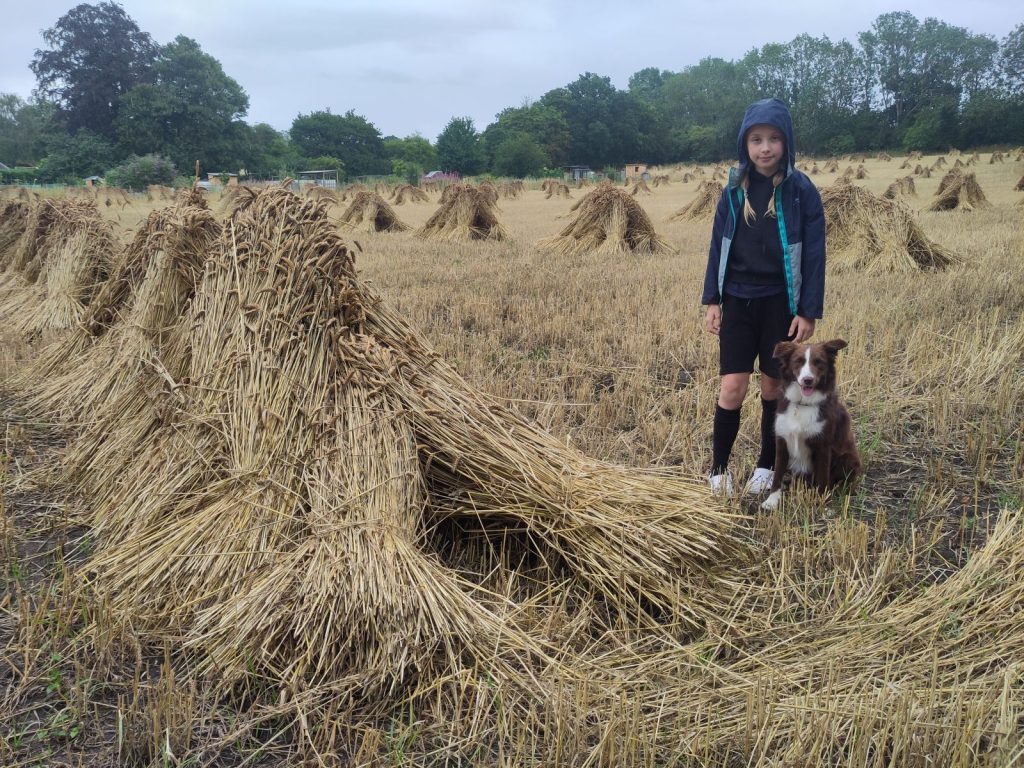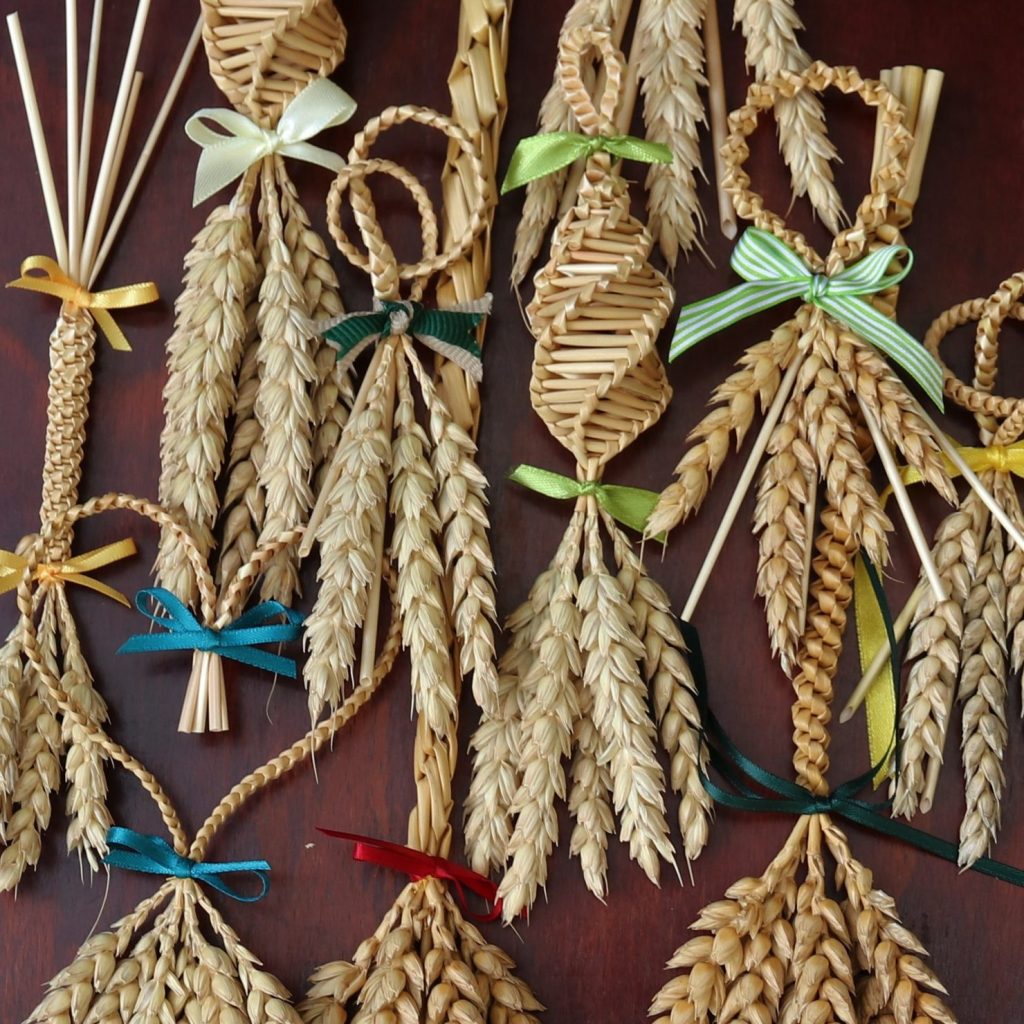Moon cycle:
- New Moon: 23rd August 2025
- Full Moon: 7th September 2025
- New Moon: 21st September 2025
Wheatsheaf
Recently, I was travelling through Suffolk and had to stop to let my dog have some exercise. We pulled up at a village called Earl Soham and I spotted a footpath leading away from the main road through a gap in a hedge. No sooner had we taken it than I felt as though we’d slipped through a time-warp. Before me, stretching out across a large field, were wheatsheaves.

Photo by David Dixon
My ten-year-old daughter had no idea what they were and I had to explain that harvests of wheat and other cereals were undertaken very differently in days gone by. In this case, the wheat had been cut either by hand scything or by a reaping machine pulled by a horse or tractor. The wheat would then be stacked together in sheaves and placed together in groups, called stooks. This process was done so that the ears of wheat (grains) inside their husks could finish ripening and drying in the field before the stooks were taken back to the farm for threshing, i.e., beaten on the ground or put through a threshing machine in the field to dislodge the grains from the husks. The remaining straw would then be put in a barn or built into a haystack as storage for feeding and bedding for various farm animals during the winter.
Harvesting then and now
Reaping and threshing machines came along in the 18th century and, at first, were powered by animals. Later, steam engines took over and became mechanically quite sophisticated, befitting the Industrial Revolution. For millennia (since the development of agriculture by humans) threshing had to be done by hand, either by beating the stalks and ears on a hard surface or laying them down and using a tool called a flail. This was a very laborious process and could damage the grains. It also required another process to remove the chaff (the rest of the material still stuck to the grain from when it was still on the plant). This was done by ‘winnowing’, i.e., tossing the grain in the air and letting the wind take the chaff away (hence the phrase ‘sorting the wheat from the chaff’, meaning selecting the useful from the non-useful).
Today, most of this harvesting process is done by one machine called a ‘combine harvester’. The straw is ejected from the combine and then a machine towed by a tractor turns it into bales which can be taken to a barn and stacked up. Bales used to be a cuboid shape but are now mostly cylindrical. The grain is stored inside the combine harvester until its tank is full. Then it is pumped into a trailer, towed by a tractor alongside, whilst still moving along harvesting the field. This process is very efficient and only requires two operators rather than the many manual workers needed in yesteryear.
Harvest Moon
But what has all this got to do with the Harvest Moon? Before the advent of mechanisation, people needed to have as much time during a day as possible in order to get the harvest in. This was greatly helped by the Harvest Moon because, if the sky was clear, the moonlight would extend the time when work could be done in the fields. This is because, in the northern hemisphere, the Full Moon closest to the September equinox is unique, as the Moon rises close to the same time several days in a row. Farmers operating combine harvesters don’t need to worry about this phenomenon as they can work through the night using powerful headlamps.
In most areas of the world there was an ancient tradition of plaiting the final ears of wheat into a ‘Corn Dolly’ (a type of idol representing the spirit of the crop and a good luck symbol). In England these dollies vary from county to county in shape, size and representation, and the tradition is still practised in a few areas. Sometimes the corn dolly is substituted for a loaf of plaited bread or one baked into the shape of a wheatsheaf to be eaten at a harvest supper.

Picture courtesy of The Basketmakers’ Association
Mechanistic Harvesting
Today most farmers in the ‘Westernised World’ harvest in a mechanistic way that seeks to bypass or subvert natural systems, rather than seeking to work with them. To accommodate large machines for ploughing, sowing, spraying and harvesting, fields have increased in size. Farmer have systematically ripped out hedges and cut down woods. The Woodland Trust estimates that, in the UK, 118,000 miles of hedgerows have been lost since 1945. However, even the most hi-tec farmer cannot escape the effects of climate change and the degradation of soils caused by ‘modern methods’ and many are starting to rethink their strategies.
Working with nature
Farmers who operate organically, using regenerative methods, try to work with nature, particularly in the way they nurture the soil, avoid synthetic chemicals and encourage biodiversity. They are also less reliant on specially-bred crops that depend upon specific chemical fertilisers and pest control (this is how large corporations keep farmers under their control). I noticed that the field of wheatsheaves, described above, had wheat with very long stalks. This fact points to it being an old variety, as modern varieties tend to have very short stalks more suited to the combine harvester. Also, there is less mixed farming (animals and arable crops on one farm), so straw as a commodity is less important.
As with other aspects of environmental stewardship, perhaps we need to look back in order to move forward in a sustainable way. The Harvest Moon can remind us about this idea by encouraging us to think about why our ancestors in the pre-industrial age considered this moon and others to be so significant. I think of this point every time I visit one of my favourite pubs called ‘The Wheatsheaf’.
Natural bounty
Of course, the concept of ‘harvest’ tends to concentrate on the human dimension, when in fact it’s a natural phenomenon and farming is merely a manipulation of it using relatively few species. In the northern hemisphere as autumn nears, we can observe many fruits, fungi, nuts and legumes of the woods and hedgerows that our ancestors cropped and some of us still forage for. Many creatures need this bounty in order to build up fat reserves for the winter or to store up and access periodically to get them through to the spring.
Related activity ideas
Draw a timeline showing the development of agriculture from neolithic times to the present day. This could be accompanied by a map showing the spread of this from the region in the Middle East and northern Africa known as the ‘Fertile Crescent’.
Go out and see a combine harvester in action. They are truly impressive machines. Find out how they developed from the early threshing machines. If you’re not in the countryside look at some videos of them in action and find out how they work e.g. https://www.youtube.com/shorts/Me43YECB_M0
Find out how people across the world harvest crops and how and why this differs from our part of the world (in terms of economic circumstances, types of crops and harvesting methods). Many religious ceremonies accompany these and it’s interesting to compare them to our Harvest Festivals past and present.
Try making a Corn Dolly. If suitable straw isn’t available, you can use art straws. See https://www.youtube.com/watch?v=YYpcfzd4ov0
Many people in other countries have to survive using subsistence farming methods. Should they be helped to mechanise? What are the costs and benefits? Is there a better way? https://www.youtube.com/watch?v=xFqecEtdGZ0&t=1s
If your school doesn’t have a Harvest Festival, organise one and show how it links to many aspects of the curriculum.
Find out what ‘Regenerative Agriculture’ is all about and how it can help alleviate climate change through the way soils are managed and be more wildlife friendly. See the film based on the book Six Inches of Soil https://www.youtube.com/watch?v=xBg9sZVuCqo
Not so long ago, we mainly ate seasonal foods. Now we can access harvests from across the globe 365 days a year. What’s the problem with this and how is it affecting our food security particularly with climate change in mind? See https://www.youtube.com/watch?v=l05pGrNmJNE
Resources and useful websites
- For more astronomical information on the Harvest Moon – visit skyatnightmagazine.com/astrophotography/moon/harvest-moon
- To find out about plant species in a hedgerow and how they can be used to date it – visit cprecheshire.org.uk/stories/how-to-date-a-hedgerow/
- For advice on foraging – visit wildlifetrusts.org/where-to-see-autumn-wildlife/foraging
- To find out about animal foraging – vistit cpre.org.uk/discover/autumn-nature-spotters-guide/
- For a view of 19th century harvesting featuring a threshing machine see https://www.youtube.com/watch?v=lcMnldjcX04
- For a literary account of a harvest at this time within a classic book read Thomas Hardy’s ‘Tess of the d’Urbervilles’.
- There are many other social economic and environmental issues surrounding the growing and harvesting of food. One of the best ways of getting into all this is to ‘Grow Your Own’ which is why children greatly benefit from having a ‘Seed to Plate’ experience i.e. planting, growing, harvesting cooking and eating. Schools that wish to develop this can be assisted by organisations such as the Royal Horticultural Society and Food For Life. A great book showing how all our food starts off with sunlight is called ‘I Ate Sunshine for Breakfast’ by Michael Holland. All this is part of a cross-curricular approach to Global Learning which is a valuable perspective for any educator. For a more academic take on this – visit angel-network.net.
Authored by Dr David Dixon, author and consultant on sustainable schools and leadership for sustainability.
